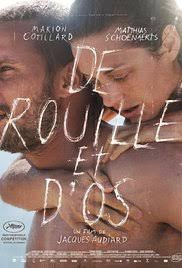Audiard presents power through the relationships in Rust And Bone. Comparing Rust and Bone to the other films we have looked at, City Of God and La Haine there is less focus on the society the film is set in, Rust And Bone focuses on the protagonists life and the hardships that his situations puts his through rather than the hardships the society he is in puts him through.
One main theme within the film is family, despite the fact he dismisses his family for the majority of the film, it is still a factor that impacts the main character. The main element of the family theme is Ali's son. He plays a big part in changing Ali. Despite appearing to brush him off, Ali's son still has a power over him, we can see this in the scene where he stops to buy a toy tractor for him, after he abused him. The guilt obviously plays on his mind. Another family aspect of the film is his sister Anna. She looks after the son and puts up with too much trouble from Ali, she experiences his true selfish and angry personality. Guilt is Ali's weakness, we can see from his performance how he guilty he felt when he found out he was the reason why Anna lost he job.
Loss is another theme present in Rust and Bone. An obvious representation of this is Stephanie losing her legs. She copes with this loss, but we can see how the loss effects until she gets prosthetic legs. The loss that she experiences in personal and causes a massive change in her life, the close up shots of her legs leaves no boundaries to the audience as every detail of her scars can be seen, this helps the audience to empathise with her as they gain a personal view of her loss through camera angles. Ali's near loss of his son made him realise how vulnerable his son is, despite hurting the little boy physically and emotionally, it took his son being in a coma to make him realise how precious he is. This break through can be represented through Ali punching the ice to rescue his son. The blood on the ice, underneath shot of the ice and the tension created during this scene can show the audience how close minded he is towards his relationship with his son and how hard it is for him to finally realise his true love for his son.
Audiard presents Ali's personality throughout the entire film through the use of his performance. He lacks the ability to plan and acts quite rashly. Particularly in the job interview for the role of bouncer we can see. Despite him having experience in fighting, we he is asked for proof we can tell by his facial expression, the way his face drops, that he has not planned for this. Another way in which the job interview reveals his personality is the fact we can see he jumps from job to job. Audiard puts Ali into different job roles that all have elements in common with each other. The fact he moves to different job helps to develop Ali's characterisation to show the audience his personality in order to help explain his other actions, such as the way he treats his son and how blunt he can be with Stephanie.
The opening credits are extremely significant for the film. To have almost poetic clips of the film and to compliment them with abstract light can almost be a synopsis for the film within the opening credits. The sound of the young boy, Sam, breathing can connote multiple things. Either he is asleep on the way down to the south of France or he is in a coma. Either way you interpret it, it is still extremely dream like from a young child's perspective almost giving a sense of hope early on in the film.




